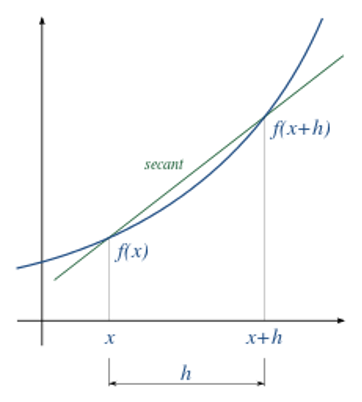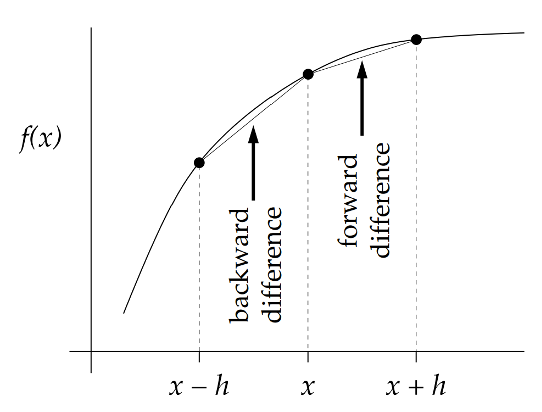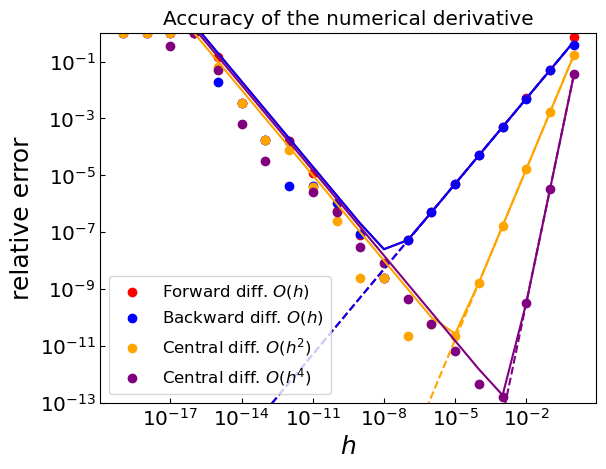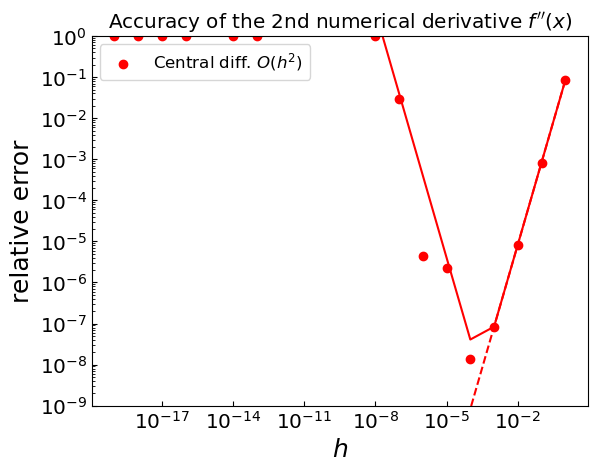Lecture Materials
Finite differences#
Basic schemes#
The problem of evaluating a derivative at a point \(x\) is ubiquitous in physics and engineering.
Although the definition of the derivative is simple, it is not always easy to evaluate it numerically. For instance this is the case when:
\(f(x)\) is a tabulated function known only at discrete points \(x_i\)
\(f(x)\) is a function that is expensive to evaluate
\(f(x)\) is defined implicitly making it challenging to evaluate the derivative efficiently
Finite differences are a simple and effective way to evaluate derivatives numerically.
Forward difference#

The forward difference approximates the limit \(h \to 0\) by a finite step \(h\):
The truncation error can be estimated through the Taylor theorem
Backward difference#

The backward difference approximates the limit \(h \to 0\) by a finite step \(h\) in the opposite (negative) direction:
The truncation error:
Central difference#
Central difference is an average of forward and backward differences and reads:
Taking the average of forward and backward differences cancels out the \(\mathcal{O}(h)\) term in the error estimate, making the central difference more accurate than the forward or backward difference:
Implementation#
def df_forward(f,x,h):
return (f(x+h) - f(x)) / h
def df_backward(f,x,h):
return (f(x) - f(x-h)) / h
def df_central(f,x,h):
return (f(x+h) - f(x-h)) / (2. * h)
Illustration#
Let us consider the function \(f(x) = e^x\) and evaluate its derivative at \(x=0\) using various methods.
import numpy as np
def f(x):
return np.exp(x)
def df(x):
return np.exp(x)
def d2f(x):
return np.exp(x)
def d3f(x):
return np.exp(x)
def d4f(x):
return np.exp(x)
def d5f(x):
return np.exp(x)
Forward difference
print("{:<10} {:<20} {:<20}".format('h',"f'(0)","Relative error"))
x0 = 1.
arr_h = []
arr_df = []
arr_err = []
arr_err_theo = []
arr_err_theo_full = []
epsm = 10**-16 # Machine epsilon
for i in range(0,-20,-1):
h = 10**i
df_val = df_forward(f, x0,h)
df_err = abs((df_val - df(x0)) / df(x0))
print("{:<10} {:<20} {:<20}".format(h,df_val,df_err))
arr_h.append(h)
arr_df.append(df_val)
arr_err.append(df_err)
df_err_theo = abs(0.5*h*d2f(x0)/df(x0))
arr_err_theo.append(df_err_theo)
df_err_theo_full = df_err_theo + 2. * epsm / h
arr_err_theo_full.append(df_err_theo_full)
arr_df_forw = arr_df[:]
arr_err_forw = arr_err[:]
arr_err_theo_forw = arr_err_theo[:]
arr_err_theo_full_forw = arr_err_theo_full[:]
h f'(0) Relative error
1 4.670774270471606 0.7182818284590456
0.1 2.858841954873883 0.051709180756477874
0.01 2.7319186557871245 0.005016708416805288
0.001 2.7196414225332255 0.0005001667082294914
0.0001 2.718417747082924 5.000166739738369e-05
1e-05 2.7182954199567173 5.000032568337868e-06
1e-06 2.7182831874306146 4.999377015549417e-07
1e-07 2.7182819684057336 5.1483509544443144e-08
1e-08 2.7182818218562943 2.429016271026634e-09
1e-09 2.7182820439008992 7.925662890392757e-08
1e-10 2.7182833761685288 5.693704999536528e-07
1e-11 2.7183144624132183 1.2005360824447243e-05
1e-12 2.7187141427020833 0.00015903952213936482
1e-13 2.717825964282383 0.000167703058560452
1e-14 2.708944180085382 0.0034351288655586204
1e-15 3.108624468950438 0.1435990324493588
1e-16 0.0 1.0
1e-17 0.0 1.0
1e-18 0.0 1.0
1e-19 0.0 1.0
Backward difference
print("{:<10} {:<20} {:<20}".format('h',"f'(0)","Relative error"))
arr_h = []
arr_df = []
arr_err = []
arr_err_theo = []
arr_err_theo_full = []
for i in range(0,-20,-1):
h = 10**i
df_val = df_backward(f, x0,h)
df_err = abs((df_val - df(x0)) / df(x0))
print("{:<10} {:<20} {:<20}".format(h,df_val,df_err))
arr_h.append(h)
arr_df.append(df_val)
arr_err.append(df_err)
df_err_theo = abs(0.5*h*d2f(x0)/df(x0))
arr_err_theo.append(df_err_theo)
df_err_theo_full = df_err_theo + 2. * epsm / h
arr_err_theo_full.append(df_err_theo_full)
arr_df_back = arr_df[:]
arr_err_back = arr_err[:]
arr_err_theo_back = arr_err_theo[:]
arr_err_theo_full_back = arr_err_theo_full[:]
h f'(0) Relative error
1 1.718281828459045 0.36787944117144233
0.1 2.5867871730209524 0.048374180359596904
0.01 2.704735610978304 0.004983374916801915
0.001 2.7169231404782224 0.0004998333751114198
0.0001 2.7181459188962975 4.999833399342759e-05
1e-05 2.7182682370785467 4.999989462496166e-06
1e-06 2.718280469160561 5.000579666768477e-07
1e-07 2.7182816886295313 5.144040337599916e-08
1e-08 2.7182818218562943 2.429016271026634e-09
1e-09 2.7182815998116894 8.411466144598084e-08
1e-10 2.7182789352764303 1.0643424035454313e-06
1e-11 2.7182700534922333 4.3317682105436e-06
1e-12 2.7182700534922333 4.3317682105436e-06
1e-13 2.717825964282383 0.000167703058560452
1e-14 2.708944180085382 0.0034351288655586204
1e-15 2.6645352591003757 0.019772257900549463
1e-16 0.0 1.0
1e-17 0.0 1.0
1e-18 0.0 1.0
1e-19 0.0 1.0
Central difference
print("{:<10} {:<20} {:<20}".format('h',"f'(0)","Relative error"))
arr_h = []
arr_df = []
arr_err = []
arr_err_theo = []
arr_err_theo_full = []
for i in range(0,-20,-1):
h = 10**i
df_val = df_central(f, x0,h)
df_err = abs((df_val - df(x0)) / df(x0))
print("{:<10} {:<20} {:<20}".format(h,df_val,df_err))
arr_h.append(h)
arr_df.append(df_val)
arr_err.append(df_err)
df_err_theo = abs(h**2 * d3f(x0)/df(x0)/6.)
arr_err_theo.append(df_err_theo)
df_err_theo_full = df_err_theo + epsm / h
arr_err_theo_full.append(df_err_theo_full)
arr_df_cent = arr_df[:]
arr_err_cent = arr_err[:]
arr_err_theo_cent = arr_err_theo[:]
arr_err_theo_full_cent = arr_err_theo_full[:]
h f'(0) Relative error
1 3.194528049465325 0.17520119364380154
0.1 2.7228145639474177 0.001667500198440488
0.01 2.718327133382714 1.6666750001686406e-05
0.001 2.718282281505724 1.6666655903580706e-07
0.0001 2.718281832989611 1.66670197804557e-09
1e-05 2.718281828517632 2.1552920850702018e-11
1e-06 2.718281828295588 6.013256095296185e-11
1e-07 2.7182818285176324 2.155308422199237e-11
1e-08 2.7182818218562943 2.429016271026634e-09
1e-09 2.7182818218562943 2.429016271026634e-09
1e-10 2.7182811557224795 2.474859517958893e-07
1e-11 2.7182922579527258 3.836796306951821e-06
1e-12 2.7184920980971583 7.735387696441061e-05
1e-13 2.717825964282383 0.000167703058560452
1e-14 2.708944180085382 0.0034351288655586204
1e-15 2.8865798640254066 0.06191338727440458
1e-16 0.0 1.0
1e-17 0.0 1.0
1e-18 0.0 1.0
1e-19 0.0 1.0
Higher-order finite differences#
To improve the approximation error one can use several function evaluations, e.g. $\( f'(x) \simeq \frac{A f(x+2h) + B f(x+h) + C f(x) + D f(x-h) + E f(x-2h)}{h} + \mathcal{O}(h^4) \)$
One can determine the coefficients \(A,B,C,D,E\) by matching the Taylor expansion of \(f(x)\) to the above expression, giving $\( f'(x) \simeq \frac{-f(x+2h)+8f(x+h)-8f(x-h)+f(x-2h)}{12h} + \frac{h^4}{30} f^{(5)} (x) \)$
def df_central2(f,x,h):
return (-f(x+2.*h) + 8. * f(x+h) - 8. * f(x-h) + f(x - 2.*h)) / (12. * h)
5-point central difference O(h^4)
print("{:<10} {:<20} {:<20}".format('h',"f'(0)","Relative error"))
arr_h = []
arr_df = []
arr_err = []
arr_err_theo = []
arr_err_theo_full = []
for i in range(0,-20,-1):
h = 10**i
df_val = df_central2(f, x0,h)
df_err = abs((df_val - df(x0)) / df(x0))
print("{:<10} {:<20} {:<20}".format(h,df_val,df_err))
arr_h.append(h)
arr_df.append(df_val)
arr_err.append(df_err)
df_err_theo = abs(h**4 * d5f(x0)/df(x0)/30.)
arr_err_theo.append(df_err_theo)
df_err_theo_full = df_err_theo + 3. * epsm / (2. * h)
arr_err_theo_full.append(df_err_theo_full)
arr_df_cent2 = arr_df[:]
arr_err_cent2 = arr_err[:]
arr_err_theo_cent2 = arr_err_theo[:]
arr_err_theo_full_cent2 = arr_err_theo_full[:]
h f'(0) Relative error
1 2.6162326091190815 0.03754180978276775
0.1 2.718272756726489 3.3373039032555605e-06
0.01 2.7182818275529415 3.3333689946350053e-10
0.001 2.7182818284586054 1.6173757744640934e-13
0.0001 2.7182818284602708 4.5090476136574727e-13
1e-05 2.7182818284769237 6.577164778196963e-12
1e-06 2.718281828295588 6.013256095296185e-11
1e-07 2.7182818296278555 4.299813100967634e-10
1e-08 2.7182818070533203 7.874726058271109e-09
1e-09 2.718281747841426 2.9657564717135134e-08
1e-10 2.7182804155737963 5.197714357668605e-07
1e-11 2.7182885572093105 2.4753688874237083e-06
1e-12 2.7187141427020833 0.00015903952213936482
1e-13 2.718196038623925 3.156031660224946e-05
1e-14 2.7200464103316335 0.0006491533931890901
1e-15 2.849572429871235 0.04829911307857894
1e-16 0.0 1.0
1e-17 3.7007434154171883 0.36142741958257013
1e-18 37.00743415417188 12.6142741958257
1e-19 370.07434154171887 135.14274195825703
Balancing truncation and round-off errors#
Let us analyze how the error of finite difference approximation depends on the step size \(h\) for the various methods.

One can see that the error of finite difference approximation exhibits a non-monotonic behavior as a function of the step size \(h\). While the increase of the error at large \(h\) is clearly due to the truncation error, the decrease at small \(h\) is less trivial.
The reason for this behavior is that the round-off error (machine precision) becomes significant at small \(h\), namely it is impossible to accurately distinguish between \(f(x+h)\) and \(f(x)\) (or between \(x+h\) and \(x\)) when \(h\) becomes too small. This leads to somewhat counterintuitive behavior that the relative error of the finite difference approximation becomes larger as \(h\) decreases.
To summarize, there are two sources of errors in the finite difference approximation:
Truncation Error: Arises from the approximation in the Taylor series expansion
Round-off Error: Arises from finite precision arithmetic in computers
Due to this balance between the truncation and round-off errors, there is usually an optimal step size \(h\) that depends on the function \(f(x)\) and the machine precision. For instance, for central difference method, the expression for the error is
By minimizing this expression with respect to \(h\), one can find the optimal step size \(h\) that minimizes the error:
For a numerical differentiation scheme with truncation error of order \(O(h^p)\), the optimal step size follows the general formula:
High-order derivatives#
Finite difference schemes for high-order derivatives are based on the same idea as for the first derivative. One can derive the schemes by applying the basic schemes to the derivatives.
Central difference for the 2nd derivative#
Central difference for the 2nd derivative reads: $\( f''(x) \simeq \frac{f'(x+h/2) - f'(x-h/2)}{h} \)$
Applying the central difference again to \(f'(x+h/2)\) and \(f'(x-h/2)\), one obtains the central difference for the 2nd derivative: $\( f''(x) \simeq \frac{f(x+h) - 2f(x) - f(x-h)}{h^2} \)$
The truncation error reads: $\( R_{f''_{\rm cent}(x)} = -\frac{1}{12} h^2 f^{(4)}(x) \)$
def d2f_central(f,x,h):
return (f(x+h) - 2*f(x) + f(x-h)) / (h**2)
Illustration#
print("{:<10} {:<20} {:<20}".format('h',"f''(0)","Relative error"))
arr_h = []
arr_d2f = []
arr_err = []
arr_err_theo = []
arr_err_theo_full = []
for i in range(0,-20,-1):
h = 10**i
d2f_val = d2f_central(f, x0,h)
d2f_err = abs((d2f_val - d2f(x0)) / d2f(x0))
print("{:<10} {:<20} {:<20}".format(h,d2f_val,d2f_err))
arr_h.append(h)
arr_d2f.append(d2f_val)
arr_err.append(d2f_err)
df_err_theo = abs(h**2 * d4f(x0)/d2f(x0)/12.)
arr_err_theo.append(df_err_theo)
df_err_theo_full = df_err_theo + 4. * epsm / h**2
arr_err_theo_full.append(df_err_theo_full)
arr_d2f_cent = arr_d2f[:]
arr_err_d2f_cent = arr_err[:]
arr_err_d2f_theo_cent = arr_err_theo[:]
arr_err_d2f_theo_full_cent = arr_err_theo_full[:]
h f''(0) Relative error
1 2.9524924420125602 0.08616126963048779
0.1 2.720547818529306 0.0008336111607475982
0.01 2.718304480882061 8.333360720313657e-06
0.001 2.7182820550031295 8.334091116267528e-08
0.0001 2.7182818662652153 1.3908112763964208e-08
1e-05 2.718287817060627 2.2030834032893657e-06
1e-06 2.7182700534922333 4.3317682105436e-06
1e-07 2.797762022055395 0.029239129204423227
1e-08 0.0 1.0
1e-09 444.08920985006256 162.3712903499084
1e-10 44408.920985006254 16336.129034990841
1e-11 4440892.098500626 1633711.903499084
1e-12 444089209.85006267 163371289.34990844
1e-13 0.0 1.0
1e-14 0.0 1.0
1e-15 444089209850062.56 163371290349907.4
1e-16 0.0 1.0
1e-17 0.0 1.0
1e-18 0.0 1.0
1e-19 0.0 1.0
Truncation vs round-off errors#

Partial derivatives#
For a function of multiple variables \(f(x, y, z, ...)\), partial derivatives measure the rate of change with respect to one variable while holding all others constant.
First-Order Partial Derivatives#
For a function \(f(x,y)\) of two variables, the first-order partial derivatives can be approximated using central differences:
These approximations have truncation error of order \(O(h^2)\).
Step size selection: Note that the optimal step size may differ for each variable
Higher-Order Partial Derivatives#
Second-Order Partial Derivatives#
For the second derivative with respect to the same variable:
Mixed Partial Derivatives#
For mixed partial derivatives, we apply the central difference formula sequentially:
This can be understood as first taking the partial derivative with respect to \(x\), and then with respect to \(y\).

